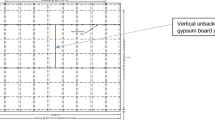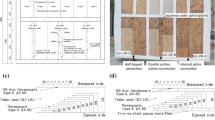Abstract
This paper presents and discusses the factors that affect the fire resistance performance of lightweight wood truss floor assemblies protected with two layers of Type X gypsum board ceiling finishes. Fifteen full-scale fire resistance floor experiments were conducted using the CAN/ULC S-101 fire resistance standard which is similar to the ASTM E119. Parameters investigated in this study include the effects of insulation installation in floor cavity, insulation type, wood truss spacing, resilient channel installation, resilient channel spacing, wood truss width, wood truss chord orientation, wood truss web type, wood truss connection type and adding concrete topping above the sub-floor. The impact of these parameters on the fire resistance performance of the wood truss floor assemblies is discussed. The fire resistance of wood truss floors appears to be essentially governed by the wood trusses’ spacing for direct application of gypsum board to wood truss framing, insulation type and resilient channel installation and spacing. Other parameters are of secondary importance.





































Similar content being viewed by others
References
National Building Code of Canada 1990 Edition (Part 9), National Research Council Canada, Ottawa, ON
National Building Code of Canada 1995 Edition (Part 9), National Research Council Canada, Ottawa, ON
Sultan MA, Seguin YP, Leroux (1998) Results of fire resistance tests on full-scale floor assemblies, Internal report No. 764. Institute for Research in Construction, National Research Council of Canada, Ottawa
Sultan M, Latour JC, Leroux P, Monette RC, Seguin YP, Henrie J (2005) Results of fire resistance tests on full-scale floor assemblies: phase II, Research report 184, Institute for research in construction 2005 edition. National Research Council Canada, Ottawa
CAN/ULC-S101 (1989) Standard methods of fire endurance tests of building construction and materials. Underwriters’ Laboratories of Canada, Scarborough
ASTM E119 (1988) Standard test method for fire tests of building construction and materials. ASTM, West Conshohocken
Sultan MA (2008) Fire resistance of wood joists floor assembles. Fire Technol 44(4):383–417
Sultan MA (2009) Fire resistance of steel C-joists floor assembles. Fire Technol 46(2):375–405
National Building Code of Canada 2005 Edition (Part 9). National Research Council Canada, Ottawa
National Building Code of Canada 2010 Edition. National Research Council of Canada, Ottawa
White RH, Cramer SM, Shresdtha DK (1993) Fire endurance model for a metal-plate-connect wood truss, Res. Pab., FRL-RP-522. US Department of Agriculture, Forest Service, Forest Products Laboratory, Madison
Shestha DK (1992) Fire endurance modeling of metal-plate connected wood truss. PhD Dissertation, University of Wisconsin, Madison
CAN/CSA-A82.31-M91 (1991) Gypsum board application. Canadian Standards Association, Rexdale
CSA A101-M83 (1983) Thermal insulation. Canadian Standards Association, Rexdale
CAN/ULC-S702-M97 (1997) Standard for mineral fibre thermal insulation for buildings. Underwriters’ Laboratories of Canada, Scarborough
CAN/CGSB 51.60-M90 (1990) Cellulose fibre loose fill thermal insulation. Canadian Standards Board, Ottawa
CAN/CSA-82.27-M91 (1991) Gypsum board. Canadian Standards Association, Etobicoke
ASTM C36-97 (1997) Standard specification for gypsum wallboard. American Society for Testing and Materials, West Conshohocken
Shorter GW, Harmathy TZ (1960) Fire Research Furnaces at the National Research Council, NRC 5732, National Research Council of Canada, Ottawa
Acknowledgments
The National Research Council of Canada wishes to acknowledge the technical and financial and in-kind contributions of the partners in this Joint Research Project. The partners include Canada Mortgage and Housing Corporation, Canadian Steel Construction Council, Canadian Wood Council, Cellulose Insulation Manufacturers Association of Canada, Cellulose Insulation Manufacturers Association (US), Forintek Canada Corporation, Gypsum Association (US), Gypsum Manufacturers of Canada, Ontario Ministry of Municipal Affairs and Housing, Owens-Corning Canada, Roxul Inc., Truss Plate Institute of Canada, Truss Plate Institute (US). Also, the author wishes to thank Jocelyn Henrie and Yves Seguin, John Latour, Patrice Leroux and Roch Monette of the Fire Research Program, National Research Council Canada for their help in constructing the assemblies and conducting the experimental work.
Author information
Authors and Affiliations
Corresponding author
Rights and permissions
About this article
Cite this article
Sultan, M.A. Fire Resistance of Wood Truss Floor Assemblies. Fire Technol 51, 1371–1399 (2015). https://doi.org/10.1007/s10694-012-0311-8
Received:
Accepted:
Published:
Issue Date:
DOI: https://doi.org/10.1007/s10694-012-0311-8




